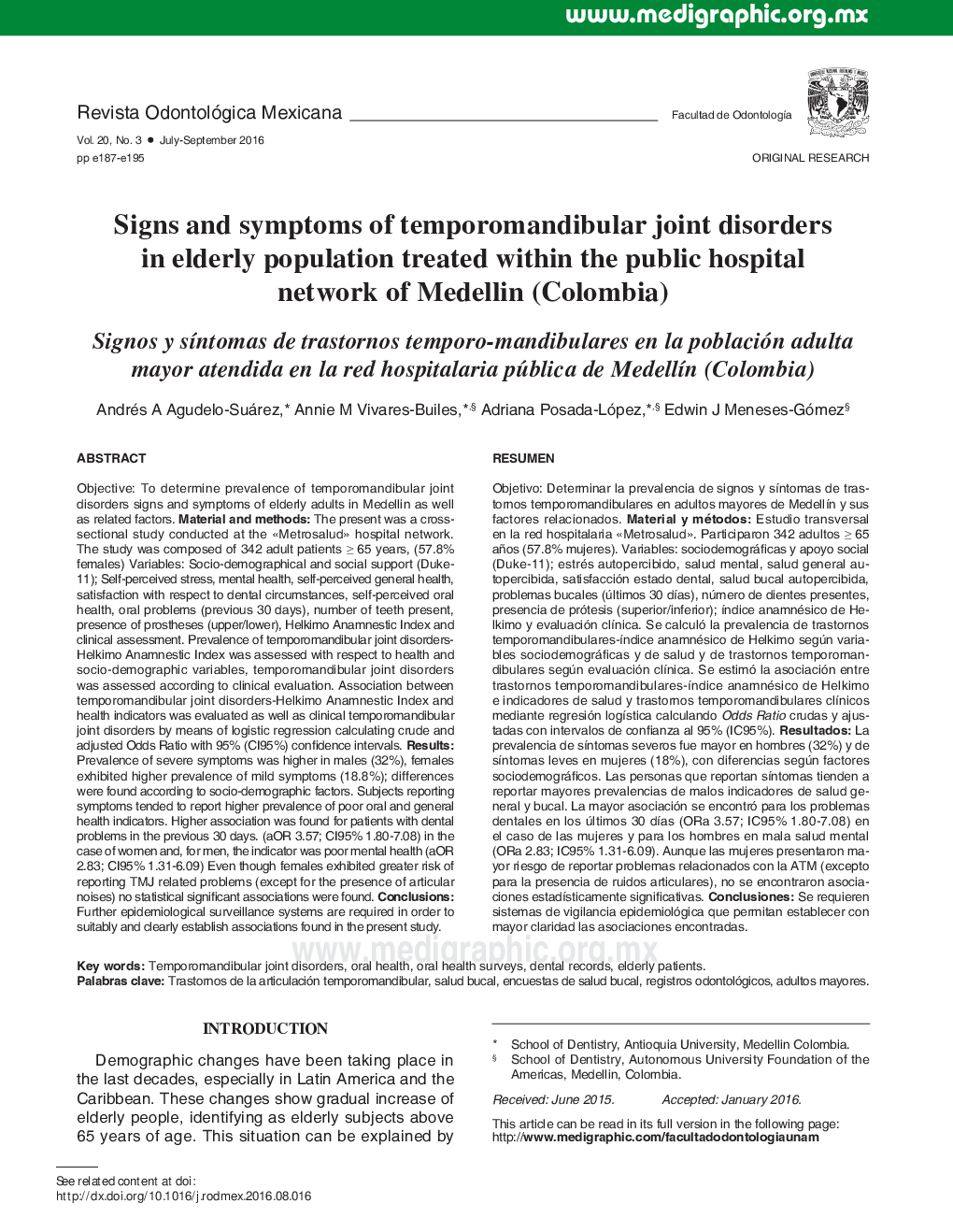| Article ID | Journal | Published Year | Pages | File Type |
|---|---|---|---|---|
| 3173073 | Revista Odontológica Mexicana | 2016 | 9 Pages |
ABSTRACTObjectiveTo determine prevalence of temporomandibular joint disorders signs and symptoms of elderly adults in Medellin as well as related factors.Material and methodsThe present was a crosssectional study conducted at the «Metrosalud» hospital network. The study was composed of 342 adult patients ≥ 65 years, (57.8% females) Variables: Socio-demographical and social support (Duke- 11); Self-perceived stress, mental health, self-perceived general health, satisfaction with respect to dental circumstances, self-perceived oral health, oral problems (previous 30 days), number of teeth present, presence of prostheses (upper/lower), Helkimo Anamnestic Index and clinical assessment. Prevalence of temporomandibular joint disorders- Helkimo Anamnestic Index was assessed with respect to health and socio-demographic variables, temporomandibular joint disorders was assessed according to clinical evaluation. Association between temporomandibular joint disorders-Helkimo Anamnestic Index and health indicators was evaluated as well as clinical temporomandibular joint disorders by means of logistic regression calculating crude and adjusted Odds Ratio with 95% (CI95%) confidence intervals.ResultsPrevalence of severe symptoms was higher in males (32%), females exhibited higher prevalence of mild symptoms (18.8%); differences were found according to socio-demographic factors. Subjects reporting symptoms tended to report higher prevalence of poor oral and general health indicators. Higher association was found for patients with dental problems in the previous 30 days. (aOR 3.57; CI95% 1.80-7.08) in the case of women and, for men, the indicator was poor mental health (aOR 2.83; CI95% 1.31-6.09) Even though females exhibited greater risk of reporting TMJ related problems (except for the presence of articular noises) no statistical significant associations were found.ConclusionsFurther epidemiological surveillance systems are required in order to suitably and clearly establish associations found in the present study.
RESUMENObjetivoDeterminar la prevalencia de signos y síntomas de trastornos temporomandibulares en adultos mayores de Medellín y sus factores relacionados.Material y métodosEstudio transversal en la red hospitalaria «Metrosalud». Participaron 342 adultos ≥ 65 años (57.8% mujeres). Variables: sociodemográficas y apoyo social (Duke-11); estrés autopercibido, salud mental, salud general autopercibida, satisfacción estado dental, salud bucal autopercibida, problemas bucales (últimos 30 días), número de dientes presentes, presencia de prótesis (superior/inferior); índice anamnésico de Helkimo y evaluación clínica. Se calculó la prevalencia de trastornos temporomandibulares-índice anamnésico de Helkimo según variables sociodemográficas y de salud y de trastornos temporomandibulares según evaluación clínica. Se estimó la asociación entre trastornos temporomandibulares-índice anamnésico de Helkimo e indicadores de salud y trastornos temporomandibulares clínicos mediante regresión logística calculando Odds Ratio crudas y ajustadas con intervalos de confianza al 95% (IC95%).ResultadosLa prevalencia de síntomas severos fue mayor en hombres (32%) y de síntomas leves en mujeres (18%), con diferencias según factores sociodemográficos. Las personas que reportan síntomas tienden a reportar mayores prevalencias de malos indicadores de salud general y bucal. La mayor asociación se encontró para los problemas dentales en los últimos 30 días (ORa 3.57; IC95% 1.80-7.08) en el caso de las mujeres y para los hombres en mala salud mental (ORa 2.83; IC95% 1.31-6.09). Aunque las mujeres presentaron mayor riesgo de reportar problemas relacionados con la ATM (excepto para la presencia de ruidos articulares), no se encontraron asociaciones estadísticamente significativas.ConclusionesSe requieren sistemas de vigilancia epidemiológica que permitan establecer con mayor claridad las asociaciones encontradas.
